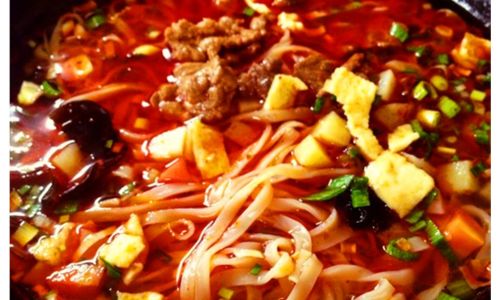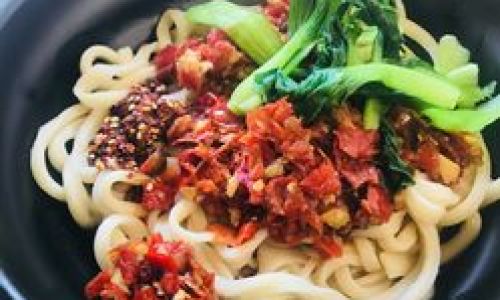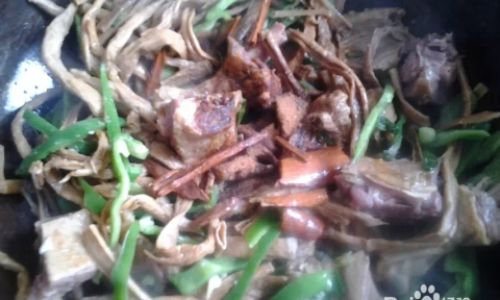Introduction

In the vast culinary landscape of China, regional dishes often serve as a testament to the country’s rich history, diverse cultures, and unparalleled gastronomic creativity. Among these, Shaanxi’s Saozi Noodles (also known as Sliced Noodles with Chili Sauce) stand out as a beloved local delicacy that has garnered a cult-like following both within China and beyond. This hearty, flavorful dish combines tender, handmade noodles with a zesty, aromatic chili sauce, making it a perfect representation of the province’s culinary heritage.
The art of making delicious Saozi Noodles lies not just in the preparation of the noodles but also in the meticulous crafting of the chili sauce, a blend of spices, oils, and meats that can elevate an ordinary meal into a culinary masterpiece. In this article, we will delve into the intricacies of preparing Saozi Noodles, from the selection of ingredients to the cooking techniques, ensuring that you can recreate this iconic dish in your own kitchen with authenticity and flavor.
Chapter 1: Understanding the Basics
Before diving into the recipe, it’s crucial to understand the fundamental components of Saozi Noodles. The dish primarily consists of three parts: the noodles, the chili sauce (or “saozi”), and the toppings. Each element plays a vital role in creating the dish’s unique taste and texture.
1 Noodles
The noodles used in Saozi Noodles are typically hand-pulled or knife-cut, giving them a chewy, al dente texture that complements the rich sauce. While fresh noodles are preferred, dried noodles can also be used, though they may require slight adjustments in cooking time.
2 Chili Sauce
The chili sauce, or “saozi,” is the heart of the dish. It’s a complex blend of chili peppers, oils, garlic, ginger, and often includes ground pork or beef. The key to a good chili sauce is balance—heat from the peppers, umami from the meat, and a hint of sweetness to round out the flavors.
3 Toppings
Toppings add an extra layer of flavor and texture to the noodles. Common choices include chopped green onions, bean sprouts, soybeans, and sometimes even a poached egg or a slice of boiled pork belly.
Chapter 2: Ingredients and Preparation
Now that we’ve established the basics, let’s dive into the specifics of preparing each component.
1 Noodles Preparation

Ingredients:
- 500g of all-purpose flour
- 200ml of water (approximately)
- A pinch of salt
Instructions:
- Mixing the Dough: In a large bowl, combine the flour and salt. Gradually add water, mixing with chopsticks or a fork until the dough starts to come together. Switch to hand-kneading until the dough is smooth and elastic, about 10 minutes.
- Resting the Dough: Cover the dough with a damp cloth and let it rest for at least 30 minutes. This allows the gluten to relax, making the dough easier to roll out and cut.
- Rolling and Cutting: Divide the dough into smaller portions and roll each into a thin sheet. Use a knife or a pasta machine to cut the sheets into thin noodles. Alternatively, you can hand-pull the dough into noodles, a technique that requires practice but yields exceptional results.
- Cooking the Noodles: Bring a large pot of salted water to a boil. Cook the noodles until al dente, about 3-5 minutes, depending on thickness. Drain and rinse with cold water to prevent sticking.
2 Chili Sauce Preparation
Ingredients:
- 200g of ground pork (or beef)
- 100g of dried chili peppers (adjust to taste)
- 3 cloves of garlic, finely chopped
- 1 piece of ginger, finely chopped
- 3 tablespoons of vegetable oil
- 2 tablespoons of soy sauce
- 1 tablespoon of rice vinegar
- 1 tablespoon of sesame oil
- 1 teaspoon of sugar
- Salt and pepper to taste
- Optional: 1 teaspoon of Sichuan peppercorns, toasted and ground
Instructions:
- Preparing the Chili Peppers: Remove stems and seeds from the dried chili peppers. Soak them in hot water for about 10 minutes to soften, then drain and chop finely.
- Cooking the Meat: In a large skillet or wok, heat the vegetable oil over medium-high heat. Add the ground pork and cook until browned, breaking it up with a spoon as it cooks.
- Adding Aromatics: Add the chopped garlic and ginger to the skillet and cook until fragrant, about 1 minute.
- Incorporating the Chili Peppers: Stir in the chopped chili peppers and cook for another 3-5 minutes, stirring frequently to prevent burning.
- Seasoning: Add soy sauce, rice vinegar, sesame oil, sugar, salt, and pepper. Taste and adjust seasoning as needed. If using, sprinkle in the ground Sichuan peppercorns for an extra layer of flavor.
- Simmering: Reduce the heat to low and let the sauce simmer for about 10 minutes, allowing the flavors to meld together.
3 Preparing Toppings
While the noodles and chili sauce are cooking, prepare your toppings:
- Green Onions: Chop finely.
- Bean Sprouts: Rinse and drain.
- Soybeans: If using dried soybeans, soak them overnight, then boil until tender. Fresh or canned soybeans can be used directly.
- Other Toppings: Poach an egg, slice some boiled pork belly, or prepare any other toppings you prefer.
Chapter 3: Assembling the Dish
With all components ready, it’s time to assemble your delicious Saozi Noodles.
Instructions:
- Plating the Noodles: Divide the cooked noodles into individual bowls.
- Adding the Chili Sauce: Spoon a generous amount of chili sauce over the noodles.
- Adding Toppings: Garnish with chopped green onions, bean sprouts, soybeans, and any other toppings you’ve prepared.
- Serving: Optionally, drizzle a little extra sesame oil or chili oil over the top for added flavor and shine. Serve immediately while hot.
Chapter 4: Tips and Variations
While the basic recipe provides a solid foundation, there are numerous ways to customize your Saozi Noodles to suit your taste preferences.
1 Adjusting the Heat

Feel free to adjust the amount of chili peppers based on your tolerance for heat. For a milder version, use fewer peppers or soak them in water for longer to reduce their spiciness.
2 Experimenting with Meats
Ground chicken, turkey, or even lamb can be used in place of pork or beef, offering different flavors and textures.
3 Adding Vegetables
Incorporate vegetables like bell peppers, carrots, or spinach into the chili sauce for added nutrition and color.
4 Sauce Variations
For a tangier sauce, add a splash of fermented black bean sauce or tofu sauce. For a sweeter profile, increase the sugar or add a touch of honey.
5 Serving Suggestions
Pair your Saozi Noodles with a side of pickled vegetables, steamed buns, or a simple green salad to balance out the rich flavors.
Conclusion
Making delicious Saozi Noodles at home requires attention to detail, patience, and a love for cooking. By following the steps outlined in this article, you’ll be able to create a dish that not only satisfies your taste buds but also brings a touch of Shaanxi’s culinary charm to your kitchen. Remember, the beauty of cooking lies in experimentation and personalization. Feel free to tweak the recipe to suit your preferences, and enjoy the journey of discovering the perfect balance of flavors that make Saozi Noodles truly special.
As you savor each bite, let the rich, complex flavors take you on a culinary adventure through the streets of Shaanxi, where the aroma of chili sauce mingles with the warmth of handmade noodles, creating a dish that is as much about tradition as it is about taste. Happy cooking!






0 comments